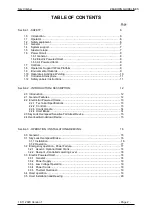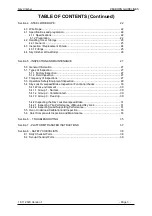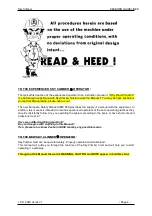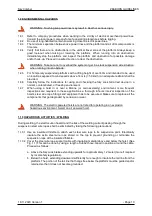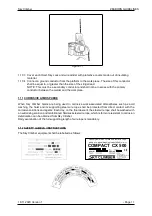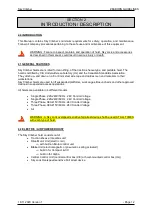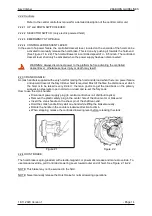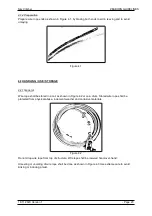
Sky Climber
ZEABORN GUIDELINES
18.11.2020 Version 1
MANGEMNT
- Page 8 -
1.5.2
Use Sky Climber specified steel wire rope, clamps, thimbles, and other work associated
components. See section 4 for more information.
1.5.3
Rig from top of structure allowing approximately 3 meter of extra steel wire rope at the bottom
to reeve hoist. Sky Climber strongly recommends that all rope drops be of sufficient length to
reach a safe surface level when reeved.
WARNING : If it is necessary to rig with less steel wire rope than specified above, it is
mandatory that the bitter end of the steel wire rope be looped back on itself and secured with
a “J”-clamp. See figure 4.4.
1.5.4
Steel wire rope must be rigged to remain vertical, with suspension points directly above the hoist
entry guide or lead-in device at all times.
1.5.5
A double wire suspension (primary and secondary safety steel wire rope) system has to be used
at all times in order to comply with company safety requirements. Make certain that each steel
wire rope is attached to its own suspension point on the suspension device.
1.5.6
Special precautions must be taken to protect the steel wire rope when welding. See section
1.10 for list of precautions.
1.5.7
Steel wire rope fittings (J-clamps, shackles and Talurit clamps) must be checked for tightness
at first loading and then at the beginning of each shift.
1.6 POWER CIRCUIT
1.6.1 General
1.6.1.1. Do not remove the motor from the hoist unless the platform is safely supported.
1.6.1.2. Optional manual crank handle can be used to raise the suspended equipment if power fails
and in order to get the load back on the primary steel wire rope in case of a power failure. This
will enable you to reset the tripped Sky Lock. Refer to section 2.2.3 on how to use the crank
handle. If Sky Lock has tripped due to overspeed do NOT crank the hoist up in order to try re-
setting the sky lock.
1.6.1.3. Emergency brake release may be used for controlled lowering of the suspended equipment
in case of power failure. See section 3.2.2.
1.6.1.4. Do not allow the electrical power supply cable / air hose to become tangled with any
obstruction or the suspension ropes when raising or lowering the suspended equipment.
Make certain the electrical cord is of sufficient length to allow full travel of the suspended equipment.
1.6.2 Electric Powered Hoists
1.6.2.1
Before using electric powered hoists, have a qualified person check the voltage while hoisting
with your maximum allowable load. The voltage should vary with no more than 10 % of the
nominal power supply voltage indicated on the electromotor data plate.
1.6.2.2
Make sure that the electrical power source is
“earthed” to a point of sufficient low resistance.
1.6.2.3
Use only approved connector plugs and power supply cords with strain relief, correctly
assembled from hoist to power supply. Verify ground continuity and use a ground fault
interrupter (as required by code in your location). Consult local safety authorities for further
information.
1.6.2.4
Ensure that all metal parts, outlets, junction boxes and other components that might come in
contact with live conductors are properly earthed.
1.6.2.5
Always use a power cable cord with earth conductor when using electrically driven hand tools
on a suspended platform. Verify that the hand tools are properly earthed. (or use hand tools
of the double insulated type)


